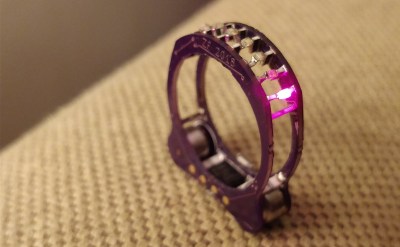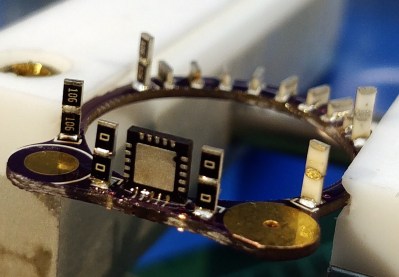You can define the word crazy in myriad ways. Some would say using SMD resistors and QFN microcontrollers as structural elements is crazy. Some would say hand soldering QFN is crazy, much less trying to do it on edge rather than in the orientation the footprint is designed for. And of course doing it live on stage in front of people who eat flux for breakfast is just bonkers. But Zach did it anyway and I’m delighted he did.
 This is the cyborg ring, and it’s a one-of-a-kind leap in imagination — the kind of leap people have come to expect from Zach Fredin who modeled neurons on PCBs, depopulated an SMD LED matrix and airwired it, and replaced his ThinkPad fingerprint reader with an ARM debugger port. The construction leverages the precise nature of manufactured parts: the ATtiny85 that drives the ring is exactly twice the width of an 0805 component. This means he can bridge the two circuit boards that make up the ring with the QFN microcontroller, and then use two 10M Ohm resistors as structural spacers in a few places around the ring. The jewels in this gem of a project are red LEDs that can be addressed in an animated pattern.
This is the cyborg ring, and it’s a one-of-a-kind leap in imagination — the kind of leap people have come to expect from Zach Fredin who modeled neurons on PCBs, depopulated an SMD LED matrix and airwired it, and replaced his ThinkPad fingerprint reader with an ARM debugger port. The construction leverages the precise nature of manufactured parts: the ATtiny85 that drives the ring is exactly twice the width of an 0805 component. This means he can bridge the two circuit boards that make up the ring with the QFN microcontroller, and then use two 10M Ohm resistors as structural spacers in a few places around the ring. The jewels in this gem of a project are red LEDs that can be addressed in an animated pattern.
 There’s an adage that all live talk demos are doomed to fail, and indeed the uC in this project doesn’t want to speak to the programmer at the end of the 9-minute exhibition. But Zach did manage to solder the two halves on the ring together live on stage, and it’s worth enduring the camera issues and low starting volume at the start of this livestream to watch him perform some crazy magic. Good on you Zach for putting yourself out there and showing everyone that there’s more than one way to stack resistors.
There’s an adage that all live talk demos are doomed to fail, and indeed the uC in this project doesn’t want to speak to the programmer at the end of the 9-minute exhibition. But Zach did manage to solder the two halves on the ring together live on stage, and it’s worth enduring the camera issues and low starting volume at the start of this livestream to watch him perform some crazy magic. Good on you Zach for putting yourself out there and showing everyone that there’s more than one way to stack resistors.
If this demo leaves you wanting to hear more of what Zach’s adventures, we recommend checking out his 2016 Supercon talk on the Neurobytes development and manufacturing process.















You forgot to put [Zach’s] name in square brackets.
(How long have you been working here? B^)
Even though the ring is cool (not wearable, but cool). That’s basic soldering. At least for me…
Look at Mr. Steady-Hands over here.
(QFNs though? That’s beyond a lotta people)
I wouldn’t say soldering them on end is basic or downplay how steady one needs to be… But soldering them flat as intended isn’t nearly as difficult as you’d think.
Agreed. That ring is huge in the world of surface mount parts. I would like to see the soldering of two stacked parts but did not get much from the video.
Oh, look, another microcontroller just got killed by ESD! Save the silicon, wear protection! :o)
I vote for this one for the circuit sculptue contest.
Video is very quiet but has a volume spike at 3:27. Your ears have been warned
I did a little of this just when smd resistors/transistors started to come out in more variety circa 1989 for a co called Bassarab Holdings as jewellery for vampire officionadoes ie Bassarab believed to be the host family name way back when, a local “entrepreneur” playing on it all sorts of weird stuff he did push outside most people’s comfort zones, learned a lot from him…
Now with more advanced electronics even smaller all sorts of extensions possible, congrats to those with the patience and skill to do one offs, maybe micro robotics to consider in near future, that would be cool imagine a replica of your human hand but tenth the size with more dexterity and motion recording with local adaptive feedbacks ?!?
Thanks for post :-)